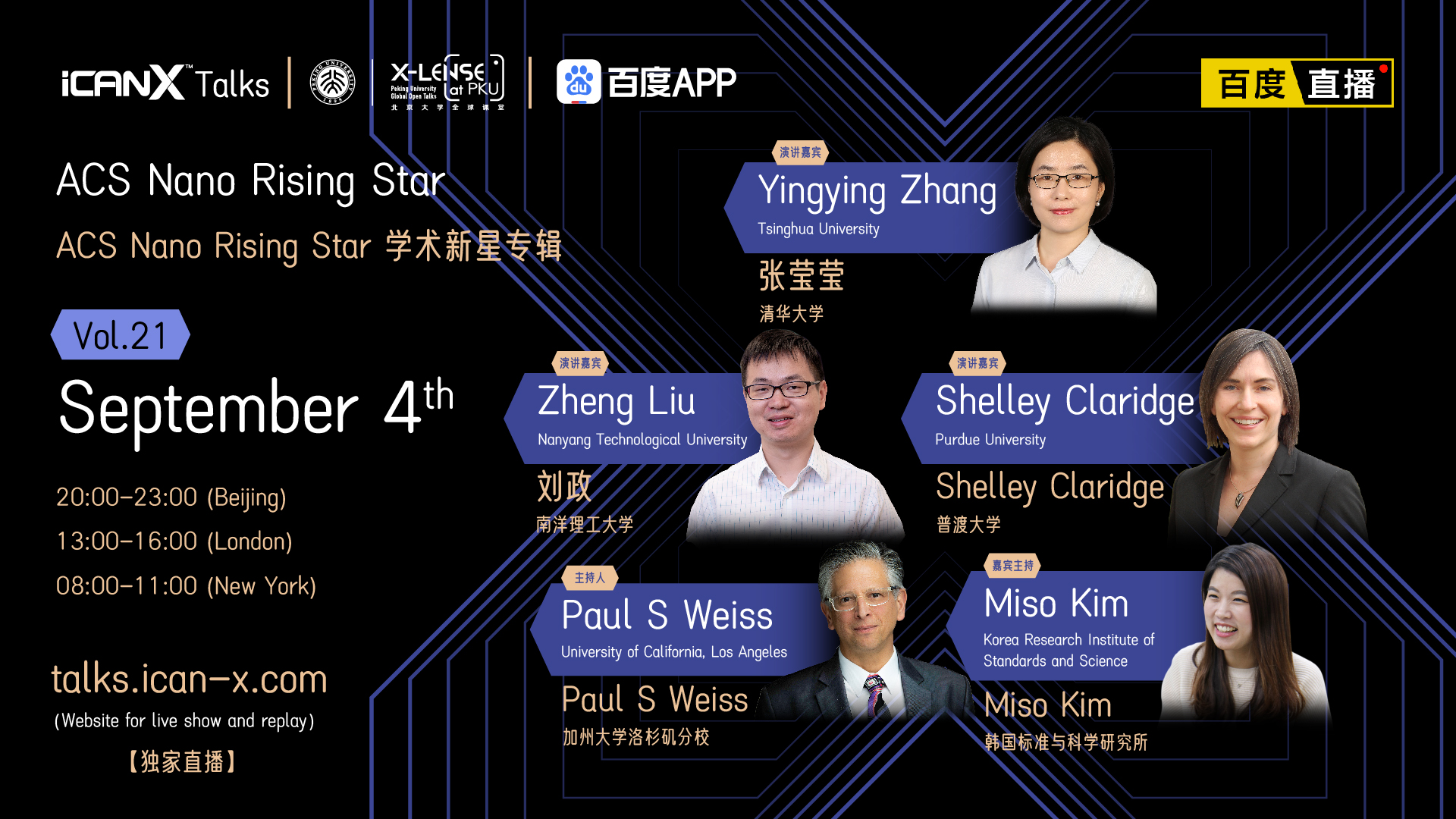博文
9月4日周五晚八点iCANX Talks第21期︱ ACS Nano Rising Star专场
|||
北京时间9月4日晚8点,大家期待已久的 iCANX Talks第二十一期即将重磅来袭,本次邀请了三位顶尖学者为大家带来最新科研成果。来自清华大学的张莹莹教授将为我们带来“面向下一代柔性电子设备的蚕丝和纳米碳材料研究”的最新进展。南洋理工大学的刘政教授将为大家介绍二维材料在构筑清洁能源和低能耗的美丽新世界上的应用。美国普渡大学的Shelley Claridge 教授将给大家带来近原子尺寸界面布图的最新研究进展。

The highly expected iCANX Talks Vol.21 will be ceremoniously holed at 8:00 pm of September 4 (Beijing time). This time, three top scholars were invited to bring you the latest scientific research reports. Professor Yingying Zhangfrom Tsinghua University will discuss the progress on exploring the potential of silk and nanocarbon toward next-generation wearables. And the professor Liu Zhen from Nanyang Technological University will introduce the use of 2D materials for sustainable word: electrocatalysis, low-power device and machine learning. Meanwhile, Prof. Shelley Claridge from Purdue University(USA) will present the latest progress on patterning interfaces near the atomic limit.
在前20期的iCANX talks直播中,每一期都吸引了全球三十余万人观看直播,累计收看观众已经近千万人次,受到了国内外专家学者的普遍好评和追捧,目前,iCANX Talks已经成为极具国际影响力的高科技云端学术峰会。
In the previous 20 weeks iCANX talks, every friday it attracted 300K+ audiences worldwide, totally close to 10 million. iCANX has been highlighted by experts and audiences globally. Now, iCANX Talks already becomes a well-known and popular international high-tech online event.
报告1
Exploring the Potential of Silk and Nanocarbon toward Next-Generation Wearables
面向下一代柔性电子设备的蚕丝和纳米碳材料研究
Yingying Zhang 张莹莹
Tsinghua University
清华大学
Abstract
The development of flexible electronics and equipment attracts significant interests in recent years. It is of great importance to explore low cost and scalable preparation approaches for high performance flexible and wearable electronics. Silkworm silk, with five thousand years’ usage history, is a popular natural material for clothes or wearing accessories. In this talk, I will present our work on exploring the application of silk fiber/fabrics together with nanocarbons in flexible electronics. We demonstrated that carbonized silk fabric with various woven structures, based on their unique N-doped graphitic carbon nanostructure and the macroscale woven structure, could be worked as strain sensors with both of high sensitivity and high tolerable strain. We also demonstrated the fabrication of high performance silk E-skin, silk/graphene E-tattoos, silk based conductive wires and conductive silk-nanocarbon ink for printing electronic. I hope that our work may help to extend the application of silkworm silk materials from traditional textile industry to next-generation wearable electronics and smart textiles.
近年来,柔性电子设备的发展引起了人们的广泛关注。探索高性能柔性和可穿戴电子器件的低成本、大规模制备方法具有重要意义。桑蚕丝,是一种具有五千年使用历史的天然纤维材料,广泛用于衣服或佩饰的制作。过去几年,我们基于蚕丝材料和纳米碳材料开展研究,力图开发其柔性电子领域的应用。例如,我们尝试了将丝绸高温碳化为碳织物材料,基于其独特的氮掺杂石墨碳纳米结构和宏观尺度编织结构,展示了其柔性传感领域的应用,实现了具有高灵敏度和大应变范围的柔性应变传感器、织物基汗液分析贴片等高性能器件的制备。另外,实现了高性能蚕丝电子皮肤、蚕丝/石墨烯电子纹身、蚕丝基导电纤维以及用于印刷电子的蚕丝-纳米碳油墨的制备。我们希望,这些探索将有助于将蚕丝的应用从传统纺织行业推广到下一代可穿戴电子设备与智能织物,赋予这种古老材料新的生机。
Biography
Yingying Zhang is an associate professor at Tsinghua University. She received her Ph.D. degree in physical chemistry from Peking University in 2007. From Jun. 2008 to Jun. 2011, she worked in Los Alamos National Laboratory (USA) as a postdoctoral research associate. Then, she joined Tsinghua University in July of 2011. Her lab focuses on the design and controlled preparation of nanocarbon, silk, and their hybrid materials, mainly aiming to develop high performance flexible electronics and wearable systems. For example, Zhang’s lab reported nanocarbon-incorporated silk fibers with obviously enhanced the strength and toughness of the silk fibers obtained by directly feeding silkworms with diets coated with CNTs or graphene. Furthermore, Zhang’s lab developed a 3D technique for printing of CNTs@silk core-sheath fibers on textile by employing a coaxial spinneret and demonstrated its applications in smart clothes.
Dr. Zhang has authored more than 110 journal papers, including Nat Nanotechnol、Nat Commun、Sci Adv、PNAS、Matter、Adv Mater、JACS、ACS Nano、Nano Lett、Adv Funct Mater etc, with more than 4500 citations. Besides, she has authored 1 book and 2 book chapters, and 15 awarded patents. She has been supported/awarded by National Science Fund for Excellent Young Scholar (2014), National Program for Support of Top-notch Young Professionals (2016), and Young Scholars of Yangtze River scholar professor program (2017).
张莹莹,清华大学副教授,博士生导师。2007年获得北京大学博士学位,2008年6月至2011年6月在美国洛斯阿拉莫斯国家实验室(Los Alamos National Laboratory)担任博士后,2011年7月起任职于清华大学。她专注于纳米碳、蚕丝及其复合材料的设计和可控制备开展研究,致力于开发新型柔性可穿戴材料和高性能柔性电子器件。例如,曾经报道了“添食育蚕法”,通过给家蚕喂食添有纳米碳材料的桑叶,获得了增强蚕丝;开发了同轴纺丝3D技术,实现了碳纳米管@蚕丝芯鞘纤维在织物上的直接制备,并展示了这种技术在智能服装上的应用;制备了丝蛋白-纳米碳“绿色”电子墨水,用于生物友好印刷电子器件的直接制备。共发表学术论文110余篇,包括Nat Nanotechnol、Nat Commun、Sci Adv、PNAS、Matter、Adv Mater、JACS、ACS Nano、Nano Lett、Adv Funct Matter等,被引4500余次。出版专著1本,参著书章2节,获授权专利15项。曾获国家优秀青年科学基金、万人计划青年拔尖人才、“长江学者奖励计划”青年学者等称号或资助。
报告2
2D materials for sustainable world: electrocatalysis, low-power device and machine learning
二维材料:构筑清洁能源和低能耗的美丽新世界
Zheng Liu 刘政
Nanyang Technological University
南洋理工大学
Abstract
Using green energy or increase energy efficiency is the key to a sustainable world. I will introduce the potentials of 2D materials to build a sustainable world in terms of low-cost H2 generation, low-power-consuming devices, and IA enabled optimization of novel materials. Semiconducting catalysts are great candidates to replace noble metal to make green energy such as H2 due to their low cost. Using 2D materials as the model system, we have revisited the semiconductor-electrolyte interface and unraveled a universal self-gating phenomenon through micro-cell based measurements . We unveiled a surface conductance mechanism that dominates the charge transport in semiconductor electrocatalysts. Based on this, we provided a guideline on how to design high-performance semiconductor electrocatalyst. Apart from the generation of green energy, we are also using 2D materials to build next-generation CMOS architecture, such as negative capacitance field-effect transistors, which may dramatically reduce the consumption of energy. Finally, I will discuss our recent progress on the machine learning guided materials synthesis, as well as the novel design of neural networks hardware based on 2D materials.
利用清洁能源、提高能效,创造一个美好的新世界,是人类孜孜不倦的追求。本次报告将从两个方面,展现二维材料在此过程中发挥的独特的作用:
1) 在清洁能源方面,氢能源一直备受青睐。由于传统贵金属,比如Pt制氢的成本高昂,基于半导体材料的电化学析氢被广泛研究。利用二维半导体材料作为模型催化体系,以及自制的微电化学系统,我们对其电解液和半导体催化剂界面的电荷输运做了细致研究,发现电催化过程自发诱导的表面电导是制约半导体催化剂性能的重要因素,此过程依赖于催化剂载流子类型以及厚度。基于此,针对不同催化反应,我们提出半导体材料的筛选策略,以此获得高性能半导体催化剂。
2) 在能效方面,信息与通讯行业成为全球第五大耗能产业,其能耗及碳排放数量占全球总量的2%- 4%,其中主要用于硅基晶体管的运算。我们利用二维材料构建了新型的二维负电容晶体管,希望突破传统硅基电子器件的热力学极限,提升电子器件的能源利用效率。除此之外,人工智能的发展也为解决能效问题提供了新的思路。最近,我们将其应用于材料合成,发现 人工智能可以显著的降低新材料合成和优化周期,大大提升材料生产效率。
Biography
Associate Professor Liu Zheng is an associate professor at MSE and EEE, NTU. He works on the synthesis of high-quality and large-size novel 2D monolayers, especially transition metal dichalcogenides (TMDs) and their applications in electronics and catalysis.
Dr. Liu is the recipient of the finalist of the World Technology Award in Energy category, Singapore NRF Fellowship, NTU Nanyang Assistant Professorship, ICON-2DMAT Young Scientist Award, Singapore Young Scientist Award (YSA), Asia’s Rising Scientists, Nano Research Young Star Editors, Nanyang Research Award and Highly Cited researcher. He held the Materials Research Society of Singapore Chair Professorship at NTU.
刘政教授于2005 年本科毕业于南开大学,2010 博士毕业于中科院国家纳米中心,之后在美国Rice 大学进行博士研究。2013年年底,入职新加坡南洋理工大学材料科学与工程学院和电子电气工程学院。与现任南洋理工大学材料科学与工程学院副教授、新加坡材料学会讲席教授。目前的主要研究方向为二维材料的合成以及器件和能源方面的应用。
所获奖项包括:世界科技奖能源类最终提名,新加坡国立基金会会士, 南洋助理教授,新加坡青年科学家奖,ICON-2DMAT青年科学家,Asia’s Rising Scientists, Nano Research Young Star Editors,南洋研究奖,高被引科学家等。
报告3
Patterning Interfaces Near the Atomic Limit: Lessons from the Cell Membrane
近原子尺寸界面布图:源自细胞膜的启迪
Professor Shelley Claridge
Shelley Claridge 教授
Purdue University, USA
美国普渡大学
Group website: www.chem.purdue.edu/claridge
课题组网站:www.chem.purdue.edu/claridge
Abstract
Many applications in modern materials science require surfaces with embedded chemical information at scales < 10 nm, to control interactions with light for energy conversion, to direct the flow of electrons, or to induce molecular recognition with receptor protein complexes on cell surfaces. Lithographic patterning rapidly becomes more expensive at scales below 100 nm, and is limited in terms of the chemistry that can be patterned. Conversely, biology generates a spectacular diversity of chemical patterns at few-nm scales, to control chemical and mechanical circuits that are central to biological function. A fundamental transformation to the molecular constituents of cell membranes enables us to use them to pattern interfaces with resolution exceeding that available at cutting edge lithographic fabrication facilities. We describe technological applications of the powerful chemical control enabled by this approach, from templating inorganic nanowires to scaffolding cell growth.
现代材料科学的许多应用需要在材料表面嵌入小于10 nm的化学信息,以此来调控光能转换,导引电子流,以及诱导细胞表面的受体蛋白复合物进行分子识别。但如系小于100 nm的界面图,则印压技术成本激增,限制了该技术在化学信息布图方面的应用。与印压技术相对,为调控对生物功能至关重要的化学和机械反应,生物学衍生出了一系列惊人的纳米级化学图案。探索思路向细胞膜分子构架的根本性转变,使我们能够利用该构架创绘先进印压技术无法企及的界面图形。从无机金属线排布,到搭造细胞生长支架,我们已在多个科技领域描绘了这一强效化学调控技术。
Biography
Shelley Claridge received undergraduate degrees in mathematics and biochemistry from Texas A&M University, and subsequently worked as a software engineer for six years prior to completing a Ph.D. at UC Berkeley with Paul Alivisatos and Jean Fréchet. After a postdoctoral fellowship with Paul Weiss at UCLA, she joined the faculty at Purdue University in 2013, and was promoted to Associate Professor with tenure in 2019. Her research at Purdue has been recognized with Young Investigator awards from NSF, DARPA (2017 Young Faculty Award and 2019 DARPA Director’s Fellowship), 3M, and DuPont (one of 8 globally in 2016), as well as emerging investigator recognitions from ACS Nano, Journal of the American Chemical Society, Chemical Communications, Analytical Methods, and Analytical and Bioanalytical Chemistry. Work from her group has also been the subject of 2 granted patents and 6 additional pending patent applications to date.
Shelley Claridge于德州A&M大学获得数学与生物学双学士学位。以软件工程师的身份工作六年后,进入UC Berkeley学习并完成Ph.D学业,师从Paul Alivisatos 和 Jean Fréchet。又于UCLA师从Paul Weiss完成博士后工作,于2013年任教普渡大学,2019年晋升为Associate Professor,取得终身教职。她在普渡的研究工作颇受认可,于多个机构获得青年科学家奖 :NSF;DARPA (Young Faculty Award, 2017; Director’s Fellowship, 2019;);3M;DuPont (2016年全球8人之一)。作为科研新秀,她的研究工作频频见刊于ACS Nano,Journal of the American Chemical Society, Chemical Communications,Analytical Methods, and Analytical 和 Bioanalytical Chemistry等。她的课题组工作已有两项获批专利和六项待批专利。
当然,除了三位重磅嘉宾,我们的主持人阵容也十分强大,是来自加州大学洛杉矶分校的Paul S Weiss教授和来自韩国标准与科学研究所(KRISS)高级研究员Miso Kim!
扫描上方二维码 查看学术报告

收看直播请点击:talks.ican-x.com
https://blog.sciencenet.cn/blog-299-1249052.html
上一篇:张海霞︱黑白之家
下一篇:夜读《往事钩沉》┃泪奔